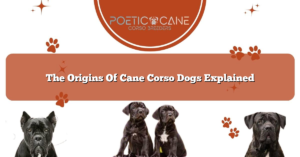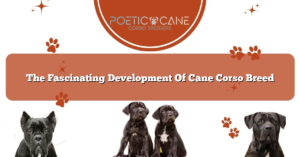You’ve always been curious about the origins of the Cane Corso, and now you’re in luck.
This comprehensive guide will take you on a journey through time, exploring the ancient Roman Molosser dogs and the historical purpose they served.
You’ll discover how influences from Italian Mastiffs and crossbreeding with other working dogs shaped this incredible breed.
Get ready to dive into the fascinating story behind the Cane Corso, a tale as captivating as a well-crafted masterpiece.
Key Takeaways
- The Cane Corso breed originated from ancient Roman Molosser dogs, known for their guarding, hunting, and battle abilities.
- The breed’s characteristics and temperament are influenced by Italian Mastiffs, known for their robust physique, protective nature, and fearless temperament.
- Crossbreeding with other working dogs, such as the Neapolitan Mastiff and Rottweiler, played a significant role in shaping the Cane Corso breed.
- The breed faced a decline and near extinction after World War II due to changing societal needs, but made a remarkable comeback and gained recognition worldwide through dedicated breeders and enthusiasts.
Ancient Roman Molosser Dogs
To understand the origins of the Cane Corso breed, you must delve into the fascinating history of the Ancient Roman Molosser dogs. These dogs were powerful and muscular, known for their strength and agility. They were used by the Romans for various purposes, including guarding properties, hunting, and even in battles.
The Molosser dogs were highly revered and respected for their loyalty and protective nature. It’s believed that the Cane Corso breed originated from these Ancient Roman Molosser dogs, with some explanations suggesting that they were a result of crossbreeding between the Molossers and other indigenous Italian dogs.
The breed’s origins are rooted in history, and understanding the connection to the Ancient Roman Molosser dogs provides valuable insights into the characteristics and temperament of the Cane Corso breed.
Historical Purpose and Roles
Did the Ancient Roman Molosser dogs serve specific historical purposes and roles? Absolutely. These powerful canines were bred for a variety of tasks that showcased their strength, loyalty, and intelligence. Take a look at the table below to see some of the key roles that Molosser dogs played in ancient Roman society:
| Roles | Description |
|---|---|
| Guard Dogs | Molosser dogs were excellent guard dogs, protecting homes and properties from intruders. |
| War Dogs | These dogs were used on the battlefield, assisting soldiers in combat and guarding camps. |
| Livestock Guardians | Molossers were tasked with protecting livestock, ensuring the safety of valuable farm animals. |
| Hunting Companions | With their keen senses and athleticism, Molosser dogs were invaluable in the hunt for game. |
| Arena Combatants | These dogs were even used in the brutal arena battles, fighting against other animals or gladiators. |
From guarding to hunting, Molosser dogs were versatile and highly valued in ancient Rome. Today, their descendants, the Cane Corsos, continue to exhibit these traits, making them exceptional companions and working dogs.
Influences From Italian Mastiffs
One of the key influences from Italian Mastiffs on the Cane Corso breed is their strong genetic lineage. These majestic dogs have a rich history that can be traced back to ancient Roman times. The Italian Mastiffs, known for their power and agility, played a crucial role in the development of the Cane Corso breed.
Here are three notable influences they had:
- Robust physique: The Italian Mastiffs contributed to the Cane Corso’s muscular build and impressive strength, making them formidable working dogs.
- Protective nature: The protective instincts of the Italian Mastiffs were passed down to the Cane Corso, making them excellent guard dogs and loyal family companions.
- Fearless temperament: The Italian Mastiffs’ fearlessness in the face of danger influenced the Cane Corso’s courageous and confident disposition, making them reliable protectors.
These influences from Italian Mastiffs have greatly shaped the Cane Corso breed into the remarkable dogs they’re today.
Crossbreeding With Other Working Dogs
As we delve into the topic of crossbreeding with other working dogs, it’s important to consider the ways in which these breed influences have further shaped the Cane Corso’s characteristics.
Over the years, breeders have selectively crossed the Cane Corso with other working dogs to enhance specific traits. One notable crossbreeding effort involved the introduction of the Neapolitan Mastiff into the Cane Corso bloodline. This cross resulted in a larger and more powerful Cane Corso, while still maintaining its agility and intelligence.
Another example is the crossbreeding with the Rottweiler, which contributed to the Cane Corso’s protective instincts and loyalty.
These intentional crosses have played a significant role in shaping the Cane Corso breed, ensuring that it continues to excel as a versatile working dog.
Evolution of the Breed Name
To understand the evolution of the Cane Corso breed name, you should explore its historical roots and linguistic influences. The breed name has undergone a fascinating transformation over the years, reflecting the breed’s rich heritage and cultural significance. Here are three key points to consider:
- Ancient Origins: The Cane Corso’s name can be traced back to ancient Rome, where it was known as ‘Canis Pugnax.’ This Latin term translates to ‘the fighting dog,’ highlighting the breed’s original purpose as a formidable protector and guardian.
- Regional Variations: As the breed spread throughout different regions of Italy, it acquired various local names, such as ‘Cane de Macellaio’ in southern Italy and ‘Cane Corso’ in the central regions. These regional variations reflect the breed’s adaptability and popularity across the country.
- Modern Standardization: In the 1980s, efforts were made to establish a standardized breed name, leading to the official adoption of ‘Cane Corso’ in 1991. This name, derived from the Latin term ‘Cohors,’ meaning ‘guardian’ or ‘protector,’ perfectly encapsulates the breed’s role and characteristics.
Decline and Near Extinction
After undergoing a fascinating transformation in its breed name, the Cane Corso faced a period of decline and near extinction. This decline can be attributed to multiple factors, including the aftermath of World War II and the changing needs of society.
As the war ravaged the Italian countryside, many Cane Corsos were lost or killed, leading to a significant decrease in their population. Additionally, the rise of industrialization and urbanization shifted the demand for working dogs, leaving the Cane Corso without a clear purpose.
These circumstances pushed the breed to the brink of extinction, with only a handful of dedicated breeders working tirelessly to preserve and revive the breed. Thanks to their efforts, the Cane Corso managed to make a remarkable comeback and is now recognized as a beloved and valuable breed worldwide.
Rediscovery and Revival
The Rediscovery and Revival of the Cane Corso breed was a pivotal turning point that breathed new life into this once endangered canine lineage. After years of decline and near extinction, the breed began to resurface in the 1970s, thanks to the efforts of dedicated breeders and enthusiasts.
Here are three key reasons why the rediscovery and revival of the Cane Corso are worth celebrating:
- Preservation of heritage: The revival ensured the preservation of the breed’s rich history and unique characteristics.
- Increased popularity: The Cane Corso’s resurgence in popularity led to a growing community of passionate owners and breeders.
- Health and vitality: Through careful breeding practices and genetic testing, the breed has regained its health and vitality, making it a robust and resilient companion.
The rediscovery and revival of the Cane Corso breed not only saved it from extinction but also ensured its future as a beloved and thriving canine breed.
Modern Standardization and Recognition
For a comprehensive understanding of the Cane Corso breed origins, it’s important to explore its modern standardization and recognition.
In recent years, the Cane Corso has gained significant recognition and popularity worldwide. The breed’s standardization is overseen by various kennel clubs, such as the American Kennel Club (AKC) and the Fédération Cynologique Internationale (FCI).
These organizations have established breed standards that outline the desired traits and characteristics of the Cane Corso. The standardization process ensures that breeders adhere to a set of guidelines when breeding Cane Corsos, promoting uniformity and maintaining the breed’s integrity.
Recognition by these kennel clubs allows Cane Corsos to compete in conformation shows and other events, further contributing to the breed’s visibility and promotion.
Through standardization and recognition, the Cane Corso has become a well-defined and respected breed in the dog world.
Cane Corso’s Appearance and Characteristics
To understand the Cane Corso’s appearance and characteristics, it’s essential to delve into its physical traits and defining attributes. Here are three key aspects that make this breed stand out:
- Powerful Build: The Cane Corso boasts a muscular and athletic body, with a deep chest and strong legs. Its overall build exudes strength and agility, making it a formidable working dog.
- Distinctive Head: One of the most noticeable features of the Cane Corso is its large and imposing head. With a broad skull and powerful jaws, it possesses a unique combination of strength and elegance.
- Intelligent Expression: The Cane Corso’s eyes are dark and alert, reflecting its intelligence and attentiveness. Paired with its well-defined facial wrinkles, it gives off an intense and focused expression.
These physical characteristics, coupled with the breed’s confident and protective nature, make the Cane Corso a remarkable companion and guardian.
Cane Corso’s Temperament and Personality
Discover the remarkable temperament and personality of the Cane Corso breed.
The Cane Corso is known for its confident and assertive nature, making it an excellent guard dog and loyal companion.
Despite its imposing size and appearance, this breed is surprisingly affectionate and gentle with its family members.
Cane Corsos are highly intelligent and eager to please, making them relatively easy to train.
They’re naturally protective and will go to great lengths to protect their loved ones.
However, proper socialization and training are essential to ensure that their protective instincts are channeled appropriately.
While they can be reserved and aloof with strangers, Cane Corsos are generally good with children and other pets when properly introduced.
With the right guidance and care, the Cane Corso can be a loving and devoted family member.
Frequently Asked Questions
How Much Exercise Does a Cane Corso Require on a Daily Basis?
You’ll need to provide your Cane Corso with a good amount of exercise on a daily basis. They are an active breed and require regular physical activity to stay healthy and happy.
Are Cane Corsos Prone to Any Specific Health Issues?
Cane Corsos are prone to specific health issues. Regular check-ups and a balanced diet can help prevent these problems. It’s important to take care of your Cane Corso’s health to ensure a happy and active life.
What Is the Average Lifespan of a Cane Corso?
The average lifespan of a Cane Corso is around 9 to 12 years. They are generally healthy dogs, but like any breed, they can be prone to certain health issues as they age.
Are Cane Corsos Good With Children and Other Pets?
Yes, Cane Corsos are generally good with children and other pets. They are known for their loyal and protective nature, making them a great addition to a family. However, proper socialization and training are important.
Are Cane Corsos Difficult to Train?
Training Cane Corsos can be challenging, but with patience and consistency, you’ll be amazed at their progress. Don’t worry, they’re not impossible to train. Just remember to use positive reinforcement and establish yourself as the pack leader.

Sydney Kimberly is a passionate Cane Corso lover and dedicated breeder. With years of experience, she’s committed to raising these majestic dogs, ensuring they thrive in loving homes. Sydney’s expertise shines in her dedication to preserving the breed’s excellence, temperament, and health. Discover more about her Cane Corso journey and insights.




